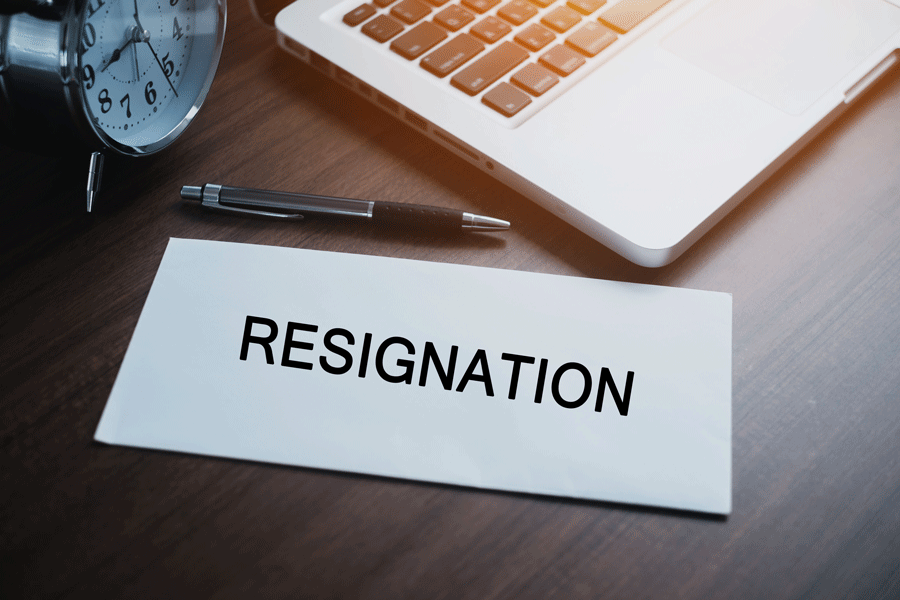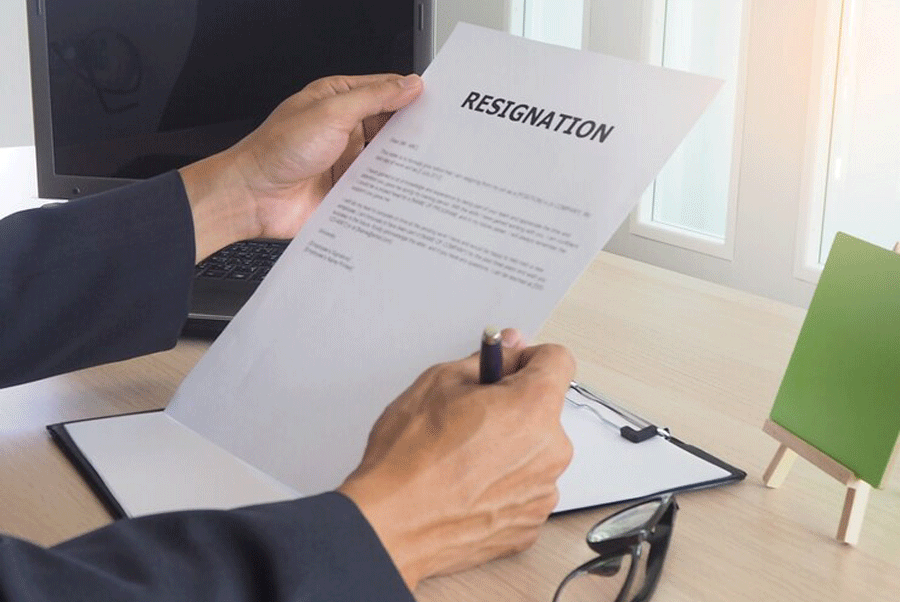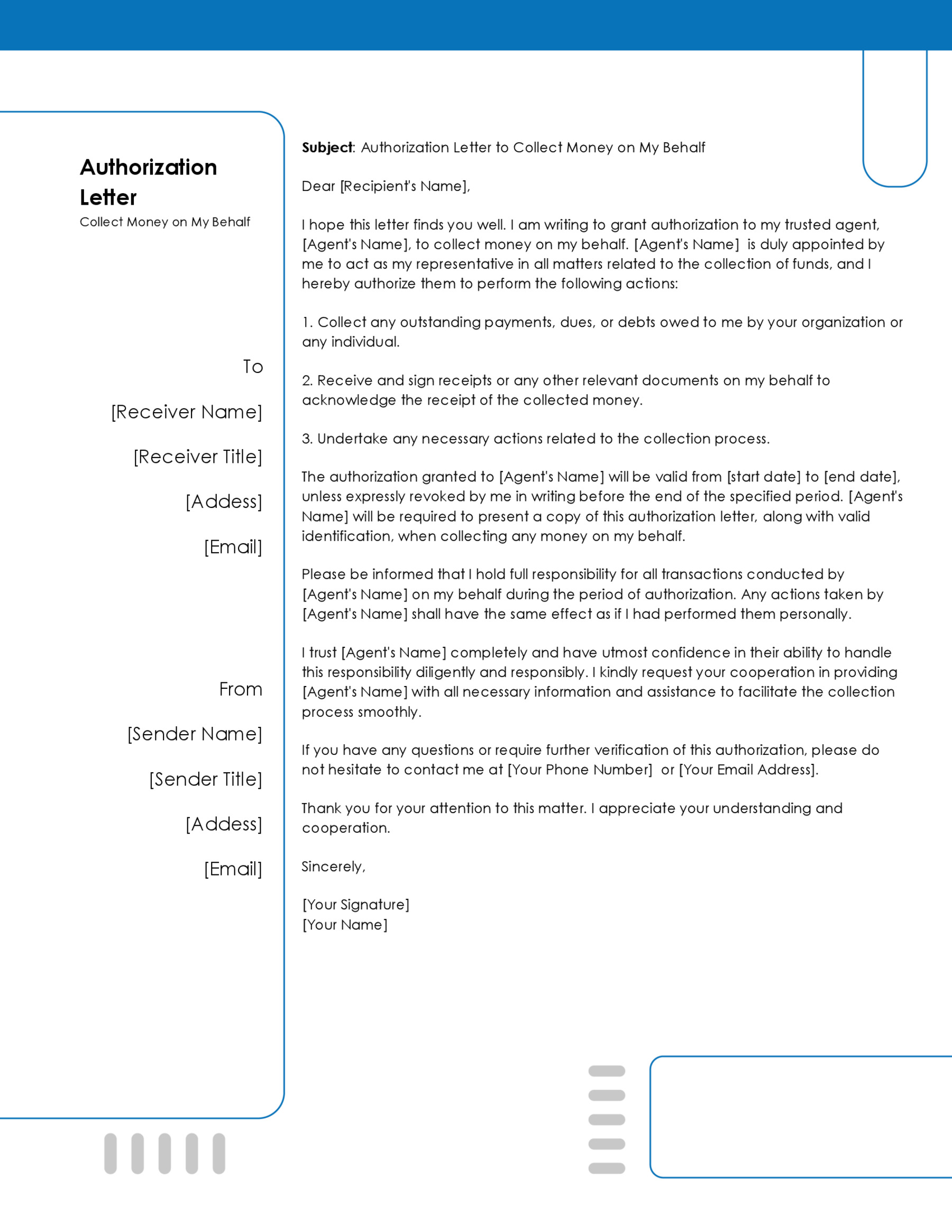You may have decided to leave your current employer to work for your dream company, start your own business, or switch to a new career. Regardless of why you are leaving your current job, you must consider the next step, as it is key to ensuring that you and your employer end things on a positive note. In most organizations, you will be required to hand in a formal resignation letter.
Writing it in a positive and diplomatic tone will have a positive impact on your last few days at the company. It will also help ensure that you can return to the company if things don’t work out in your new job, obtain a reference letter, or work together with your current boss on a professional basis in the future.
This begs the question of what a resignation letter is. How can you write one? And what are the do’s and don’ts? This article will help you answer all these questions to make the writing process more manageable.
A formal resignation letter is an official document used to notify your employer of your decision to leave your current position. It explains why you are leaving and indicates your last day on the job. It is a record of proof that notice was provided to the employer. It is usually submitted after you verbally inform your employers of your decision to resign to avoid catching them off guard.
Free Samples
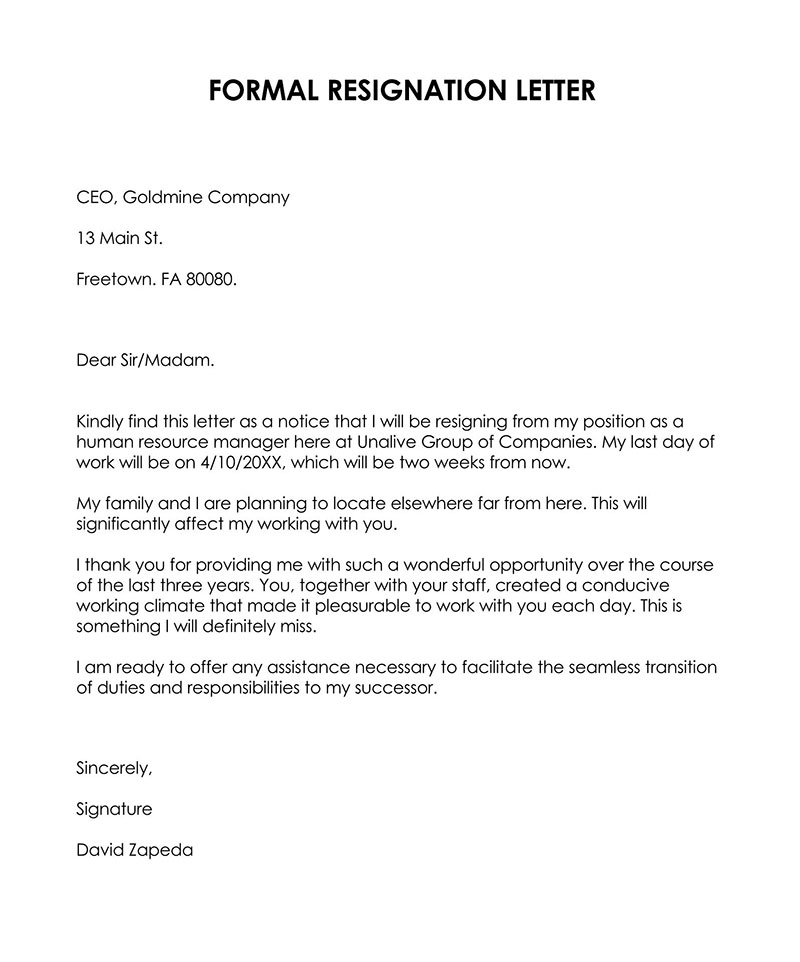
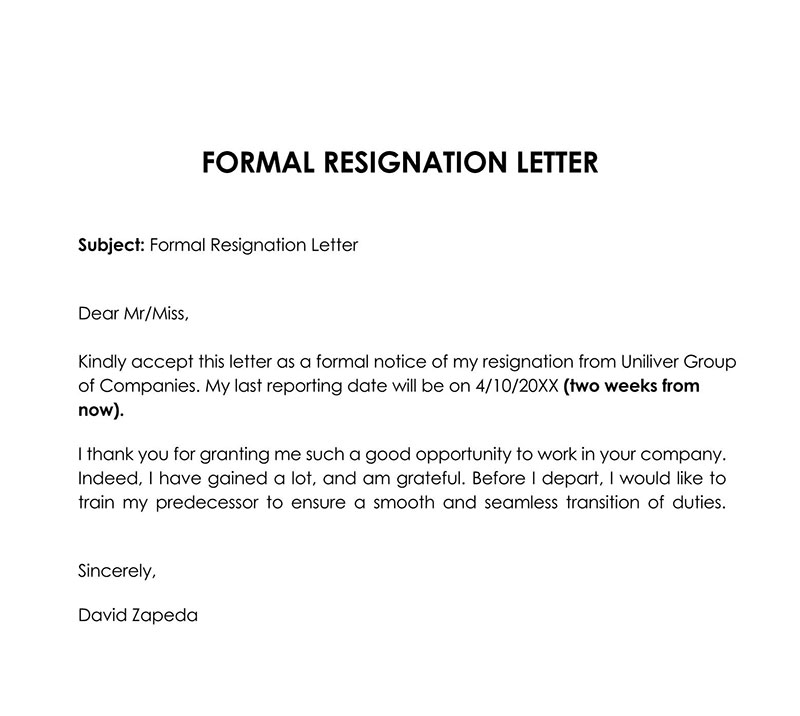
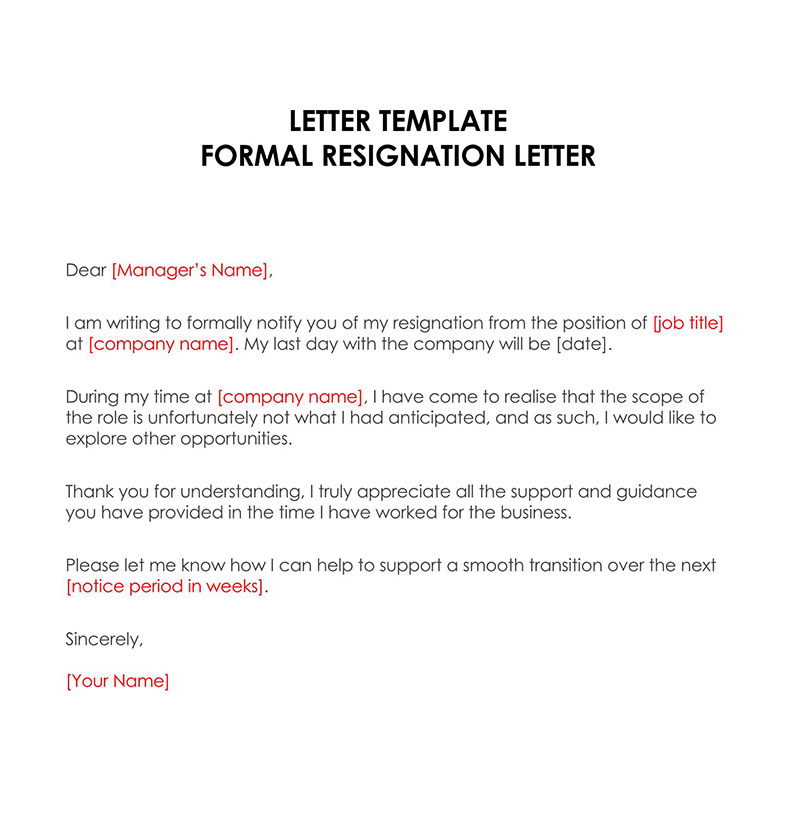
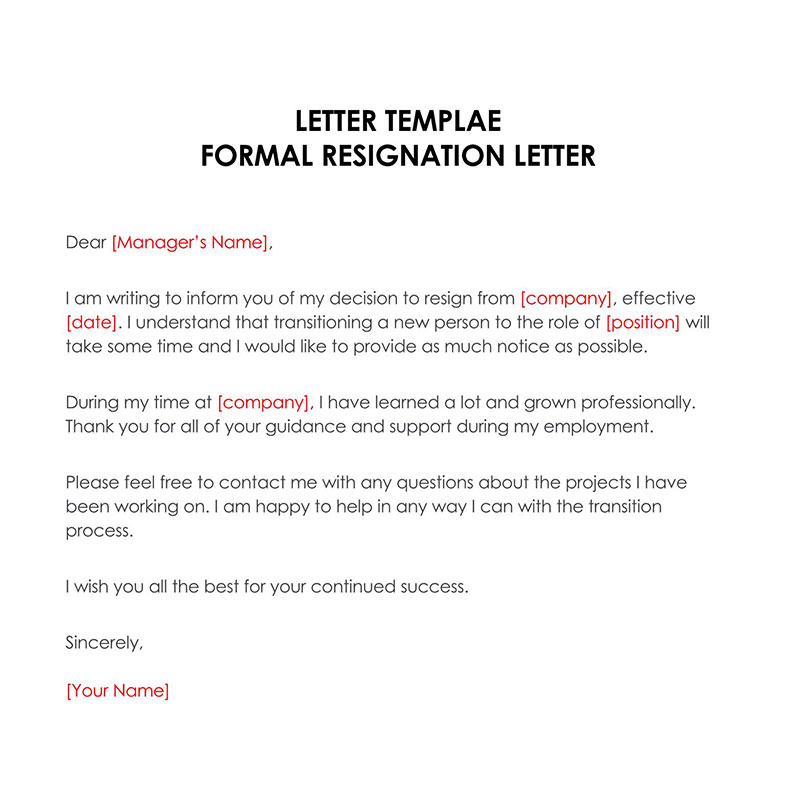
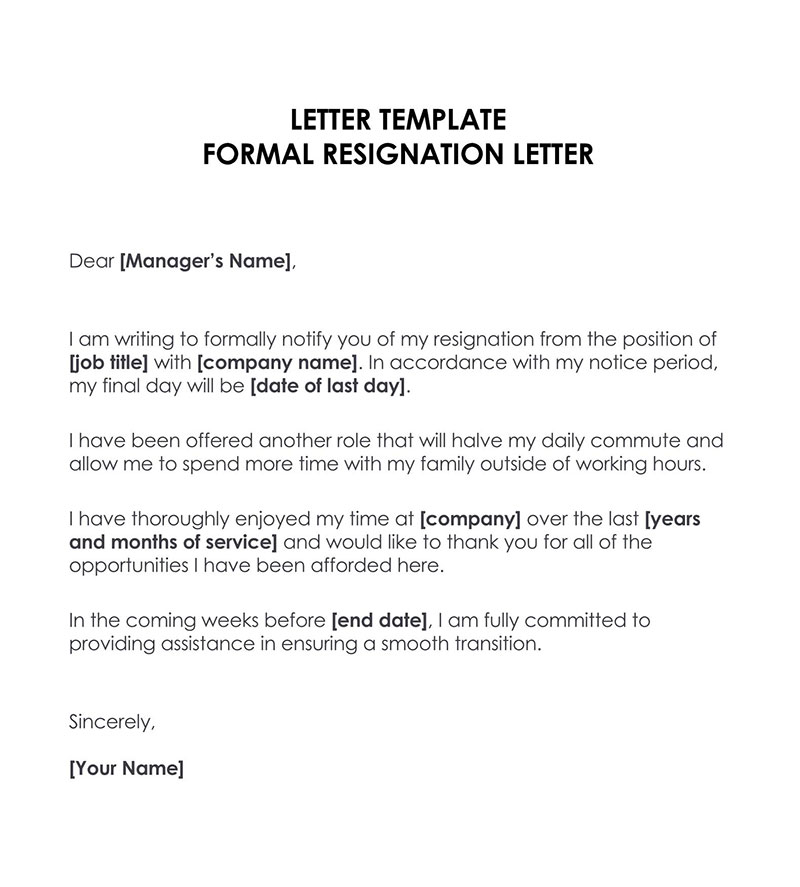
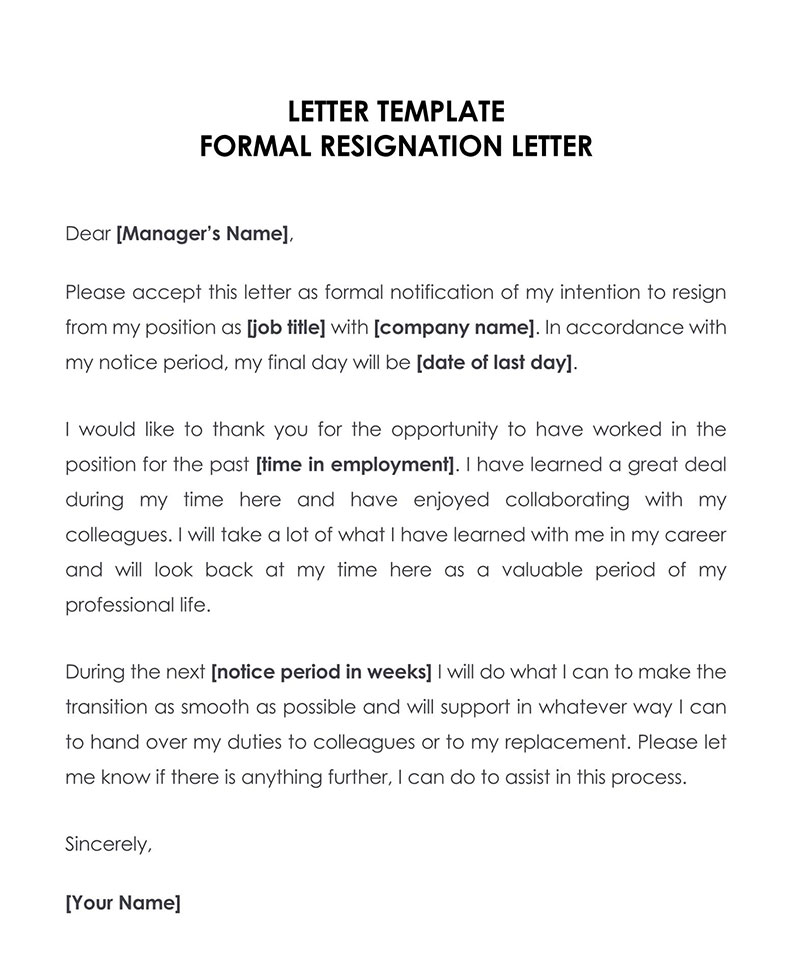
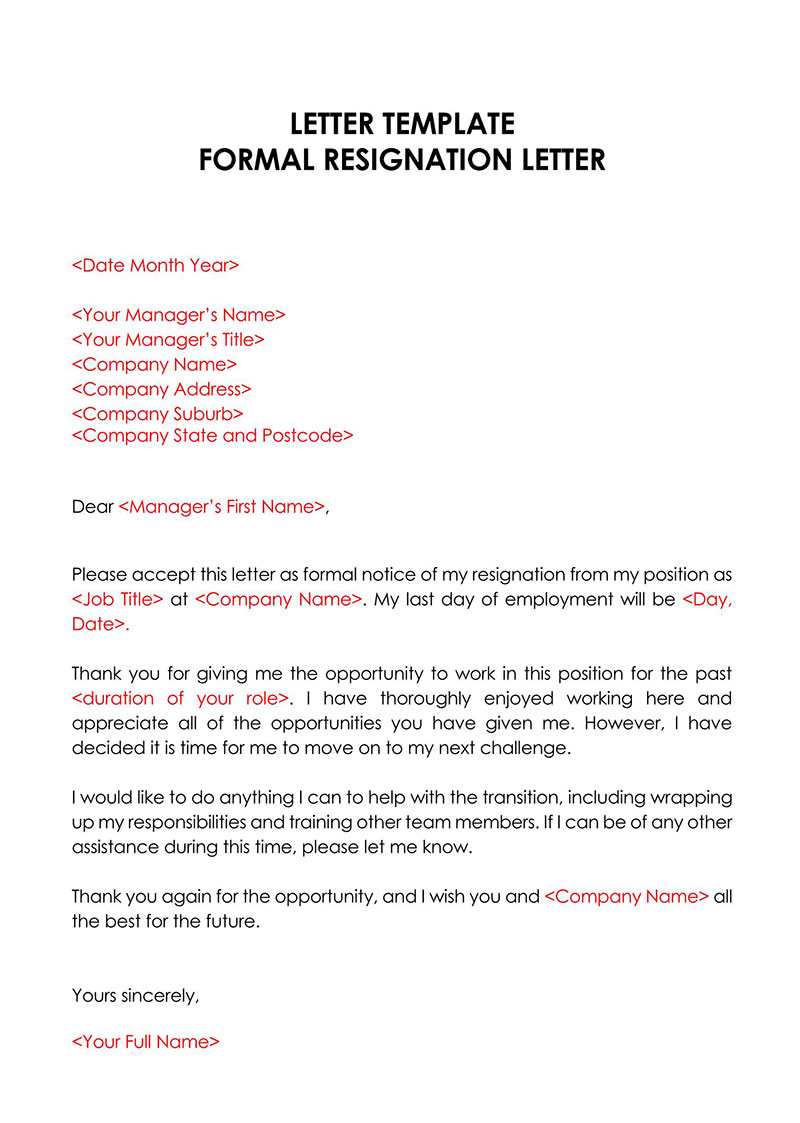
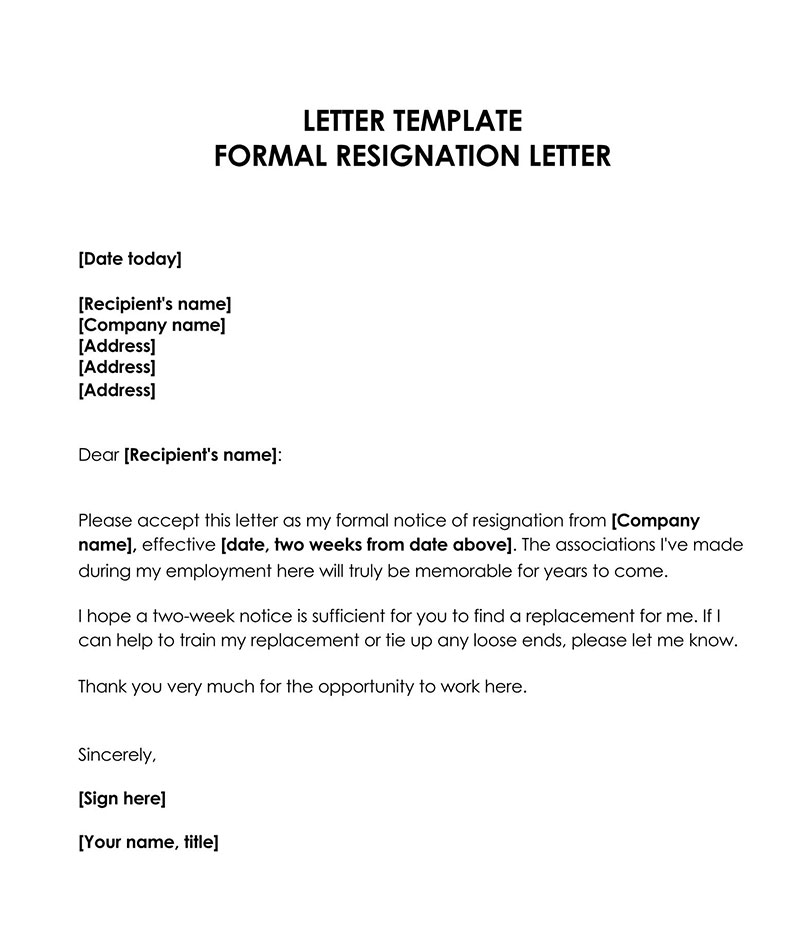
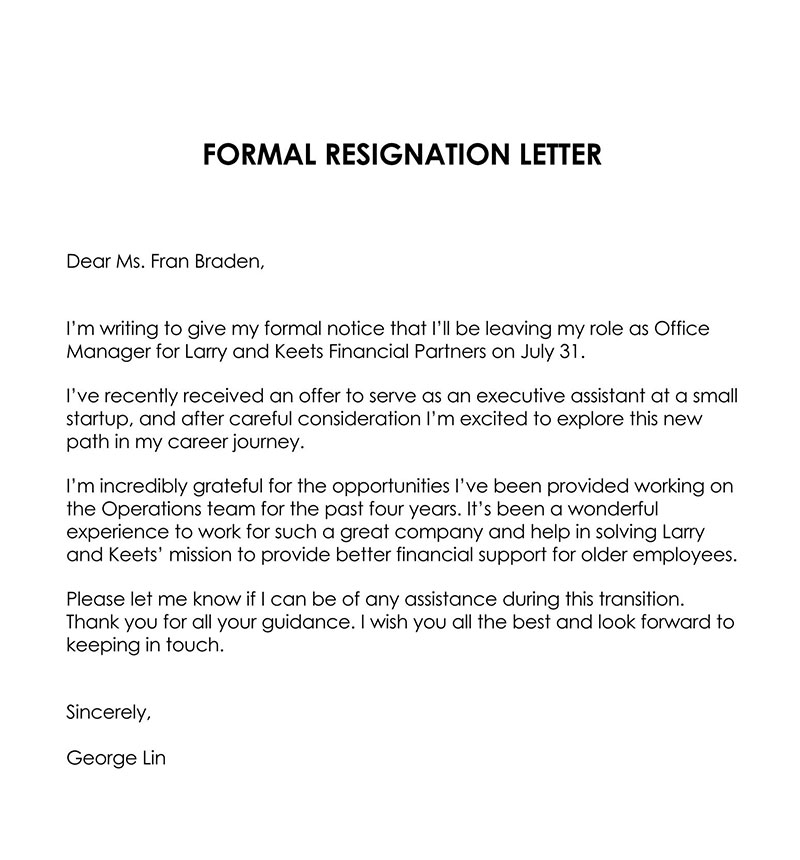
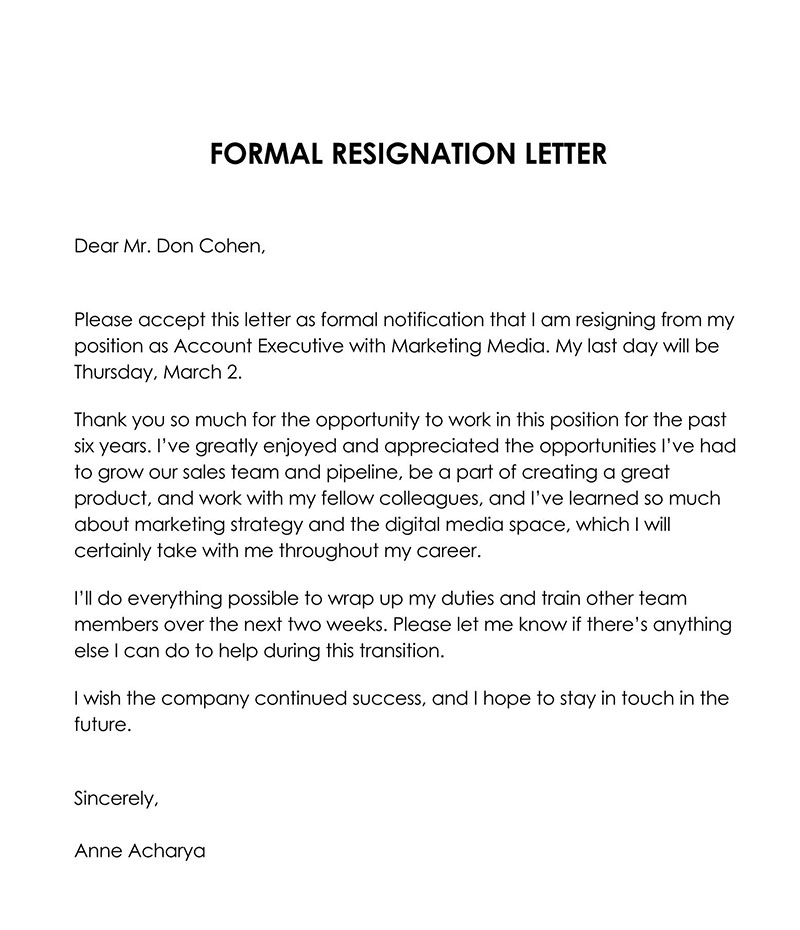
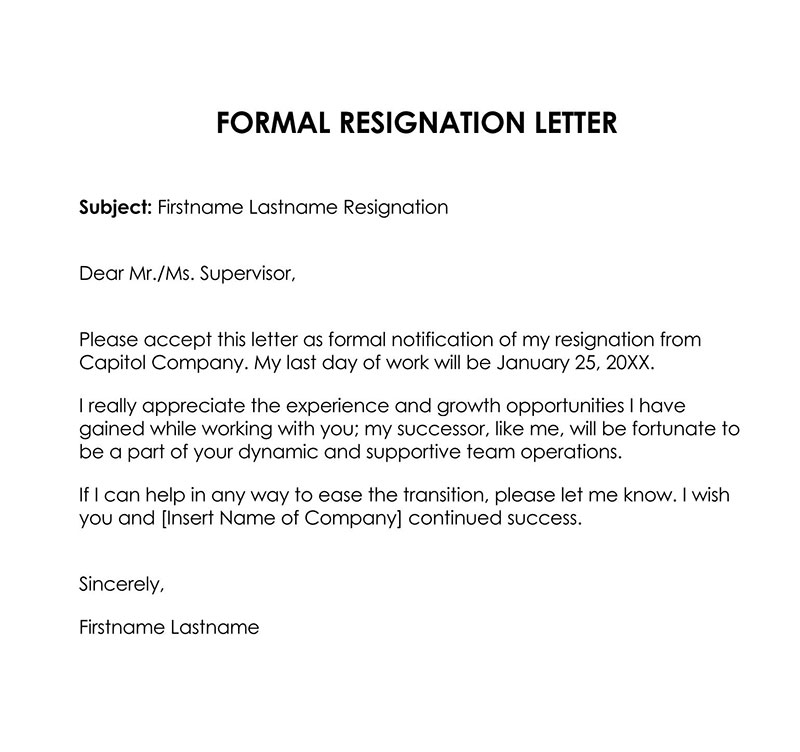
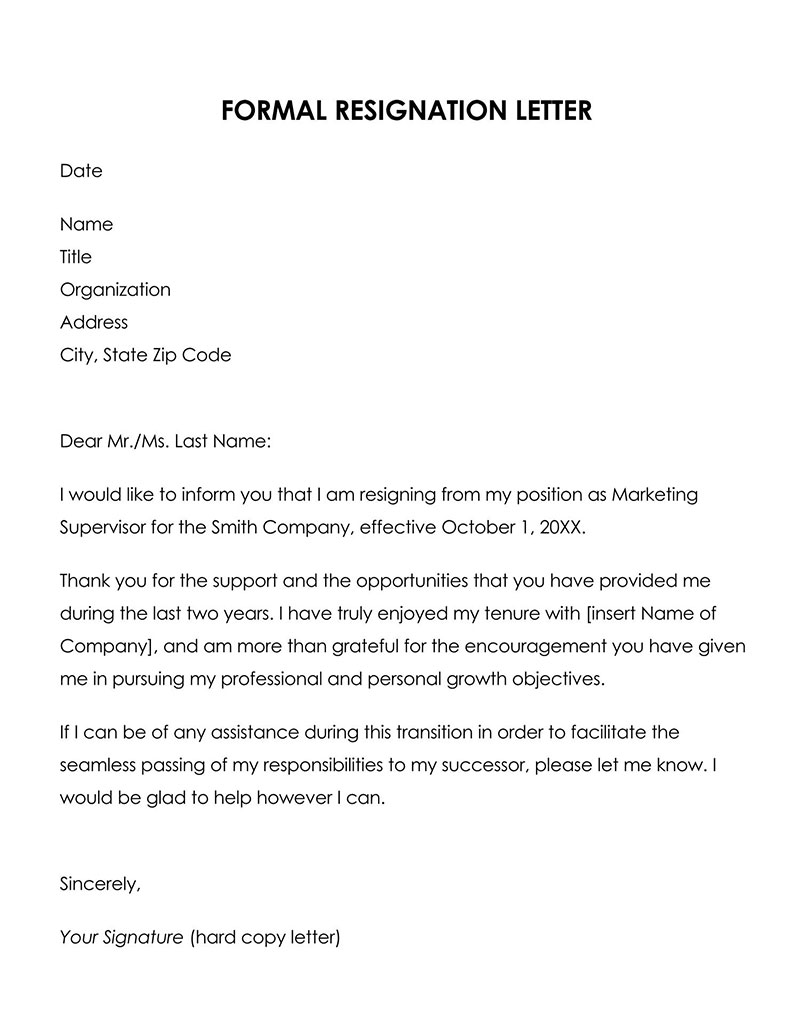
Reasons for Writing One
Writing a formal letter will help you maintain good relations with your employer even after your employment ends. This can come in handy when you need a reference letter from your soon-to-be-ex employer. The employer may also refer to the letter when deciding whether a counteroffer should be made to keep you from leaving or if you can return to the company. It enables you to ensure that you do not say something that can spread and affect how others in the field perceive you.
Information to be Included
The elements of the letter help to effectively communicate your decision to resign from the current job. They also help ease the writing process by narrowing down the information you are required to provide. Therefore, you must clearly understand what should be included.
The information required includes the following:
Employer’s information
It would be best if you began by indicating the date of writing. You should state the employer’s name, title, department, and company name and address. These details help identify the recipient of the letter.
EXAMPLE
May 5, 20xx
Susan Wolf
Human Resource Department,
ABC Company,
56 Pilgrim Road
New York, NY 7779
Greeting
Secondly, you should greet the recipient directly by their last name. Depending on the position you occupy and the organization’s setup, you may be required to address the letter to your supervisor, an HR representative, the team department, or the company. Therefore, you should use a formal greeting when addressing the recipient:
EXAMPLE
Dear Mr. Wolf
Subject line
Thirdly, you should indicate the letter’s purpose in a simple subject line. The subject line is an easy way of informing the recipient of what the letter is about. It should contain your full name.
EXAMPLE
Subject line: Alice Green Resignation Letter
Your intention to resign
Your introductory statement should outline your intention to resign from the organization. It should contain the title of the position you are leaving. When indicating these details, you should ensure that you go straight to the point to avoid wasting the employer’s time with unnecessary information.
EXAMPLE
This letter is to notify you that I am resigning from my position as the lead graphic designer at ABC Company.
Departure date
Next, you should indicate the departure date to ensure that the employer knows when your last day of work will be. Indicating the date allows the employer to prepare for your departure, such as preparing your last paycheck and the expiry of your benefits, among others. The date indicated also provides the employer with time to find your replacement. You can provide a two-week, 24-hour, or immediate notice. If you cannot provide an early notice, indicate an apology to show that you acknowledge that it is on short notice. You should also indicate any tasks you need to complete before leaving, like a project.
EXAMPLE
March 22 will be my last day. I only have one remaining project that will need to be reassigned to someone else.
A brief note on the reason for leaving
You should then indicate a clear reason as to why you are resigning from the company. Writing a brief civil explanation that does not contain personal details will help you maintain professionalism. You may state that you are resigning due to health concerns, financial benefits, or relocation, among others.
EXAMPLE
I have received a job offer from a new company.
A thank you
It would be best to express your appreciation for the opportunity and experience gained while working at the company. Mention specific experiences, lessons, or opportunities you are thankful for. It helps show that you acknowledge the time and effort invested in you.
EXAMPLE
Thank you for the opportunity you have given me. Working at ABC company has enabled me to hone my skills as a graphic designer. Though my departure saddens me, I believe that this is the start of a bigger and better thing for myself and the company.
Offer to assist in the transition
Continue by offering to help with the transition process. For example, you can offer to help with tasks like finding your replacement and training them before you leave, among others. This offer shows that you are aware of the disruption your departure will cause and that you are willing to help make it seamless.
EXAMPLE
I would be happy to help find my replacement and anything else you may need during this transition period. My team is well-trained and ready to take on some of my tasks and responsibilities if a replacement is not found in my place.
Your contact information
Finally, you should end it by signing off using an appropriate closing word or phrase such as ‘Sincerely’ or “Kind regards.” When submitting a hard copy letter, you should ensure you indicate a signature above your printed name. Next, provide your address and contact information if they haven’t been indicated in the header. These details will help you and your employer stay connected even after your departure.
EXAMPLE
Sincerely,
[Your Signature]
Alice White
321 Main Street
New York, NY 2782;
555-675-2675
alicewhite@gmail.com
Free Template for Resignation Letter
[Your Name]
[Your Address]
[City, State, Zip Code]
[Email Address]
[Phone Number]
[Today’s Date]
[Recipient’s Name]
[Recipient’s Title]
[Company Name]
[Company Address]
[City, State, Zip Code]
Dear [Recipient’s Name],
I am writing to formally announce my resignation from [Your Position] at [Company Name], effective [Last Working Day, typically two weeks from the date you submit the letter].
This decision was not easy and took careful consideration. However, after [briefly outline your reasons, such as focusing on personal goals, pursuing a different career path, or other opportunities], I believe this is the best decision for my career and personal growth.
I want to express my sincere gratitude for the opportunities I have been given at [Company Name]. Working here has been a significant part of my career, and I am thankful for the skills, experiences, and professional relationships I have built during my time with the company. I have enjoyed being part of the team and am proud of what we have accomplished together.
Please let me know how I can assist during the transition period. I am willing to help train my replacement or ensure a smooth handover of my responsibilities to another team member.
Thank you once again for the opportunity to work at [Company Name]. I look forward to staying in touch, and I hope to cross paths again in the future.
Sincerely,
[Your Name]
Sample Resignation Letters
Sample 01 Resignation due to health reasons
Dear Mr. Smith,
I am writing this letter to formally resign from my position as Marketing Coordinator with XYZ Corporation, effective two weeks from today, March 1, 20XX. After much consideration and consultation with my healthcare providers, I have made this difficult decision due to unforeseen health issues that require my immediate and full attention.
I cannot express enough how challenging it is to step away from a role and team that I am deeply passionate about. However, at this time, I must prioritize my health and follow the advice of my medical team. I hope to resolve these health concerns and possibly explore future opportunities to work together again.
Please be assured that I am committed to assisting in the transition process. I am prepared to help train a replacement or to hand over my responsibilities to ensure a seamless transition for the team. I have also documented my current projects and responsibilities to facilitate the handover.
I want to extend my deepest gratitude for the opportunities for professional and personal development that you have provided me during my time at XYZ Corporation. I have thoroughly enjoyed my tenure with the company and feel honored to have worked with such a supportive team and management.
Thank you for your understanding and support regarding this difficult decision. I look forward to staying in touch and sincerely hope to cross paths again in the future. Please let me know if there is any further information or documentation you need from me at this time.
Sincerely,
Jane Doe
Sample 02 Resignation due to relocation
Dear Mrs. Thompson,
I am writing to formally resign from my position as Project Manager at Innovatech Solutions, effective March 15, 20XX. This decision comes after much deliberation and is due to my family’s impending relocation to New York, a move necessitated by personal reasons and family commitments.
Working at Innovatech Solutions has been a highly rewarding experience, and I am genuinely saddened to leave. I have greatly appreciated the opportunities for growth and development that have been afforded to me here, as well as the chance to work with such a talented and dedicated team.
I am committed to ensuring a smooth transition and will do everything in my power to wrap up my duties and assist in finding and training my replacement. I have prepared detailed documentation of my current projects and am willing to provide additional support remotely, if necessary, following my move.
Please let me know how I can further assist in the coming weeks. I hope to maintain the professional relationships and friendships I have developed at Innovatech Solutions and look forward to staying in touch.
Thank you for your understanding and support during this transition. I am grateful for the invaluable experience and knowledge I have gained during my tenure, and I leave with nothing but respect and admiration for you, the team, and the company.
Sincerely,
Alex Rivera
Sample 03 Email format
Subject: Resignation – Jordan Matthews
Dear Ms. Harper,
I hope this email finds you well. After considerable reflection on my career and personal goals, I have made the difficult decision to resign from my position as Senior Graphic Designer at Creative Solutions, effective two weeks from today, March 2, 20XX. This decision was not made lightly, but due to personal reasons, I find it necessary to step down and focus on new challenges.
I am deeply grateful for the four enriching years I have spent with Creative Solutions. It has been a privilege to work alongside such a talented and dedicated team, contributing to projects that have not only pushed my creative boundaries but also led to significant achievements for the company. The support, mentorship, and opportunities for professional growth I have received here have been invaluable to my career.
Understanding the impact of my departure, I am fully committed to ensuring a smooth and seamless transition. I am prepared to assist in the training of my successor and will provide comprehensive documentation of my ongoing projects to guarantee continuity in our work. Additionally, I am available to offer my support and guidance remotely, if needed, following my last day.
I want to extend my heartfelt thanks to you, the team, and the entire company for the wonderful experiences and memories. I am hopeful that we can stay in touch and possibly collaborate again in the future.
Please consider this email as my formal resignation notice. I will be in touch with HR to complete any necessary exit paperwork and I am open to discussing the next steps at your convenience.
Thank you once again for the opportunity to be part of Creative Solutions. I wish you and the company all the best and am excited to see the continued success of the team.
Warm regards,
Jordan Matthews
Senior Graphic Designer
jordan.matthews@email.com
(555) 123-4567
Key Takeaways
These three resignation letters, each with a distinct context—health issues, relocation, and personal reasons—demonstrate how to resign professionally and gracefully. Key elements across the letters include:
- Each letter begins by clearly stating the intent to resign, specifying the position and effective date. This direct approach ensures there’s no ambiguity about the letter’s purpose.
- The writers provide a brief explanation for their departure—health issues, family relocation, and personal reasons—without delving into unnecessary detail. This maintains professionalism while offering transparency.
- All letters include heartfelt thanks for the opportunities provided by the employer, acknowledging the growth, support, and experiences gained during their tenure. This reinforces the writer’s positive feelings toward the company and its people.
- The resigning employees express their willingness to help with the transition, whether through training a replacement or documenting current projects. This gesture of support demonstrates responsibility and a continued commitment to the company’s success, even as they prepare to leave.
- The letters are professionally written, with a respectful tone throughout. By keeping the message positive, the writers leave on good terms, preserving their professional relationships and reputation.
- Each letter concludes with a forward-looking sentiment, expressing hope for future interactions and gratitude for the shared time and experiences. This optimistic closure leaves the door open for potential future collaborations or re-employment.
Together, these elements create resignation letters that are respectful, considerate, and professional, setting a positive tone for the writers’ departures and maintaining good relations with their soon-to-be former employers.
Do’s and Don’ts
There are several do’s and don’ts that you should consider when writing a formal resignation letter. These do’s and don’ts will help ensure that your letter communicates your intention to resign more effectively.
Do’s
It is vital to consider practices that will help ease the writing process. They include the following:
Keep it positive and short
You should ensure that the letter is positive to help leave a good impression as you depart. It should also be a short letter of 2- 3 paragraphs. Writing a short letter will ensure that only relevant information is captured.
Provide a formal letter
Writing a formal letter enables the employer to keep comprehensive documentation of your time at the company by providing closure to your employment records. It will also help ensure that you provide relevant information. You can either opt to send an email or a hard copy letter.
Proofread and edit
Once you’re done writing, proofread the letter to help free it of any spelling and grammatical errors. It will help ensure that your letter is polished and that your employer has an easy time reading it.
Maintain a formal tone
The relationship shared with your employer is formal; hence, the resignation letter must maintain a formal tone. It ensures that the contents are taken seriously. Using a formal tone will also ensure that your employer reacts appropriately to the letter.
Be gracious
It would help to be gracious to ensure that things end cordially. This will make future interactions with the employer pleasant. It will also demonstrate your professionalism.
Don’ts
You must consider the practices that should be avoided during the drafting process. Knowing this information will help you ensure that you do not make these mistakes.
The following should be avoided when writing a letter:
Don’t brag about your new job
Do not use it to brag about your new job. Remember that you may need a recommendation from the employer. You may also need to return to the company if things at your new job won’t work out.
Tell the whole truth (Avoid lengthy explanation)
Lengthy explanations about why you have decided to resign are not required. You can opt to use your exit interview to vent your frustration rather than doing so in the letter.
Leave without notice
Do not submit it without providing prior notice. You should provide the employer with ample notice for adequate preparation for your departure. Companies will usually indicate in their policies and procedures how much notice they should provide.
Reasons why you hated your job
You should avoid providing reasons why you hated your job. This is unnecessary, as you did not raise any issues on the matter. Instead, you can provide vague details on what you gained from the position.
Negative comments about your boss
Do not use it to make negative comments about your employer, as it may come back to haunt you in the future, even if there is a new boss. Your comments may gravely impact your career, especially if your new employer is informed of your unprofessional and disrespectful behavior.
Criticism of your peers
Criticizing your peers should be avoided, as it shows that you cannot work well with others. It also makes your letter seem overly critical.
Inappropriate language
You should avoid using inappropriate language, like obscenities. This type of language should not exist in a formal document. Instead, choose your words carefully so as not to offend the employer.
Unnecessary information
Do not provide unnecessary details that have nothing to do with the employer. The employer doesn’t need to know where you’re moving to, what your new salary will be or what position you have been offered. It would be best to take adequate time to filter out what is relevant and what is not.
Threats
Indicating threats could land you in serious trouble. Remember that the letter can be used as evidence against you. In addition, it could negatively affect any chances you may have of securing employment.
Emotional statements
Do not include emotional statements in it, regardless of whether they are good or bad. Instead, it would be best to express them in person. Your emotional sentiments do not contribute to the severe nature of the letter.
Spelling and grammar errors
Submitting a letter with numerous spelling and grammatical errors is unacceptable. It shows a complete lack of motivation. Furthermore, such a letter will easily frustrate and confuse the reader.
Final Remarks
A formal resignation letter helps you inform your employer of your decision to quit your current position. It contains information on why you have decided to resign and when your resignation will come into effect. In addition, a well-written letter ensures that you maintain a cordial relationship with your employer even after you leave the company.
You should write a brief resignation to ensure that you only focus on providing relevant information to the employer. Do not brag, criticize, or use inappropriate language, as these are clear signs of unprofessionalism. Proofread the letter once it is complete to ensure no spelling and grammatical errors. It would help to consider using a formal template and reading a sample to help you understand how it is structured.





